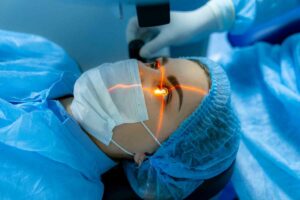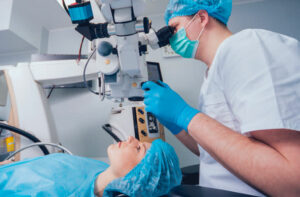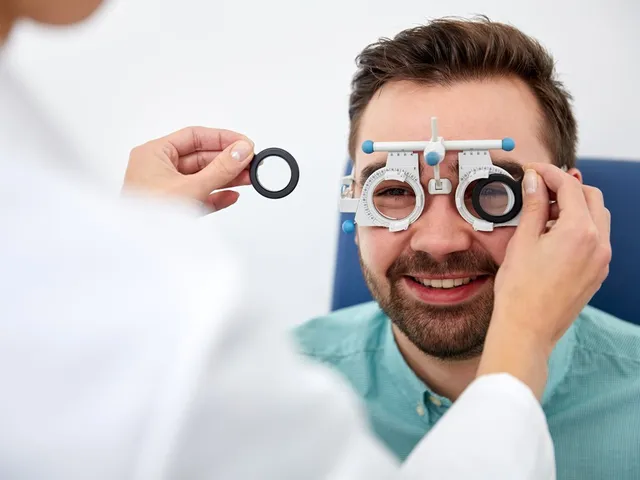You must be knowing that LASIK and Cataract surgeries have transformed the lives of millions by improving vision and restoring clarity. But do you know what these surgeries do and how do they differ? In this article, we’ll explore the differences between these surgeries, their purposes, potential complications, and the importance of seeking professional guidance.
Contents
What Is LASIK Surgery?
LASIK (Laser-Assisted in Situ Keratomileusis) surgery is a popular and effective refractive eye surgery used to correct common vision problems such as nearsightedness, farsightedness, and astigmatism. During the procedure, a laser is used to reshape the cornea to improve its focusing ability. This helps to reduce or eliminate the need for glasses or contact lenses. LASIK surgery is typically quick, safe, and provides long-lasting vision improvement.
You can see a detailed explanation of LASIK eye surgery in the video given below.
What Is Cataract Surgery?
Cataract surgery is a common surgical procedure performed to treat cataracts, which are the clouding of the natural lens of the eye. The surgery involves removing the cloudy lens and replacing it with an artificial intraocular lens (IOL) implant. The procedure is typically done on an outpatient basis and usually takes less than an hour. Cataract surgery aims to restore clear vision, improve visual quality, and reduce the impact of cataracts on daily activities.
Have a look at this detailed explanation of Cataract eye surgery in the video given below.
Difference Between LASIK And Cataract Surgeries
LASIK and cataract surgeries are both eye procedures, but they differ in their purpose and the conditions they address.
Purpose
 LASIK surgery is primarily performed as an elective procedure for individuals with stable refractive errors who wish to reduce their reliance on glasses or contact lenses. It aims to correct nearsightedness, farsightedness, and astigmatism by reshaping the cornea, allowing light to focus properly on the retina.
LASIK surgery is primarily performed as an elective procedure for individuals with stable refractive errors who wish to reduce their reliance on glasses or contact lenses. It aims to correct nearsightedness, farsightedness, and astigmatism by reshaping the cornea, allowing light to focus properly on the retina.
On the other hand, cataract surgery is necessary when cataracts develop, which is the gradual clouding of the eye’s natural lens. The purpose of cataract surgery is to remove the cloudy lens and replace it with an artificial intraocular lens (IOL) implant to restore clear vision.
Underlying Condition
LASIK surgery is not performed to treat cataracts but rather to address refractive errors in individuals with otherwise healthy eyes. The surgery is suitable for those who have stable prescriptions and meet certain eye health criteria.
Cataract surgery, however, is specifically intended for individuals with cataracts that cause significant vision impairment. Cataracts commonly occur with age but can also develop due to other factors such as injury, certain medications, or underlying medical conditions.
Procedure
 LASIK surgery involves creating a thin flap on the cornea, either with a microkeratome blade or a femtosecond laser, and using an excimer laser to reshape the underlying corneal tissue. This reshaping adjusts the focusing power of the cornea, allowing light to be properly focused on the retina.
LASIK surgery involves creating a thin flap on the cornea, either with a microkeratome blade or a femtosecond laser, and using an excimer laser to reshape the underlying corneal tissue. This reshaping adjusts the focusing power of the cornea, allowing light to be properly focused on the retina.
In cataract surgery, a small incision is made on the cornea or the lens capsule, and the clouded natural lens is gently fragmented and removed using ultrasound energy (phacoemulsification). An artificial intraocular lens (IOL) is then inserted to replace the removed lens, restoring clear vision.
Timeframe
LASIK surgery is typically a quick procedure, lasting about 15 minutes per eye. Both eyes can often be treated on the same day, allowing for a faster visual recovery.
In contrast, cataract surgery may take slightly longer, typically ranging from 15 to 30 minutes per eye. If both eyes require cataract surgery, the surgeries are usually scheduled on separate occasions, typically a few weeks apart, to allow for proper healing and evaluation of the first eye.
Cost Of LASIK And Cataract Surgeries
 The cost of LASIK and cataract surgeries can vary depending on various factors, including the geographical location, the specific clinic or hospital, the surgeon’s expertise, the type of technology used, and any additional procedures or services involved. It’s important to note that these cost estimates are general and can differ significantly:
The cost of LASIK and cataract surgeries can vary depending on various factors, including the geographical location, the specific clinic or hospital, the surgeon’s expertise, the type of technology used, and any additional procedures or services involved. It’s important to note that these cost estimates are general and can differ significantly:
LASIK Surgery: The cost of LASIK surgery typically ranges from INR 80,000- 1 Lakh per eye in India. However, prices can vary, and it’s advisable to consult with different providers to get accurate estimates. Additionally, factors such as the type of laser used, the surgeon’s experience, and the complexity of your vision correction needs can influence the cost.
Cataract Surgery: The cost of cataract surgery varies based on several factors, including the type of intraocular lens (IOL) chosen and any additional services or procedures required. In India, the cost of cataract surgery per eye can range from INR 15,000- 30,000. This estimate usually includes the cost of the surgery itself, the IOL, pre-operative and post-operative care, and follow-up visits. However, if you opt for premium IOLs or advanced technologies, the cost can be higher.
Can A Patient Go For Both LASIK And Cataracts?
Yes, a patient can undergo both LASIK and cataract surgeries, depending on their specific eye conditions and needs.
In some cases, individuals who have previously undergone LASIK surgery may develop cataracts later in life. If cataracts develop and significantly affect vision, cataract surgery can be performed to remove the clouded natural lens and replace it with an artificial intraocular lens (IOL). Cataract surgery can be performed even if the patient has had LASIK surgery in the past.
Which One Has More Complications?
 LASIK and cataract surgeries are generally safe and have high success rates. However, it’s important to note that both procedures, like any surgical intervention, carry potential risks and complications. The incidence and severity of complications can vary depending on several factors, including the patient’s overall health, pre-existing eye conditions, surgical technique, and individual healing response. Here’s an overview of potential complications associated with each surgery:
LASIK and cataract surgeries are generally safe and have high success rates. However, it’s important to note that both procedures, like any surgical intervention, carry potential risks and complications. The incidence and severity of complications can vary depending on several factors, including the patient’s overall health, pre-existing eye conditions, surgical technique, and individual healing response. Here’s an overview of potential complications associated with each surgery:
LASIK Surgery complications:
- Dry Eyes
One of the most common complications after LASIK is temporary or persistent dryness of the eyes. This can cause discomfort, irritation, or visual disturbances.
- Flap Complications
Since LASIK involves creating a corneal flap, there can be rare complications related to flap dislocation, epithelial ingrowth (cells growing under the flap), or flap irregularities.
- Visual Disturbances
Some patients may experience glare, halos, double vision, or other visual disturbances, especially in low-light conditions.
Cataract Surgery complications:
- Infection
Although rare, there is a risk of developing an infection following cataract surgery. Appropriate post-operative care and medications can manage such conditions.
- Retinal Detachment
Although rare, cataract surgery can increase the risk of retinal detachment, particularly in individuals with certain risk factors.
- Other potential complications
Swelling, inflammation, increased intraocular pressure, or issues related to pre-existing eye conditions can occur, but these are generally managed effectively.
Summary
| Aspect | LASIK Surgery | Cataract Surgery |
|---|---|---|
| Purpose | Correct refractive errors | Remove clouded lens |
| Underlying Condition | Stable refractive errors | Clouding of natural lens |
| Procedure | Reshaping cornea with laser | Removal of the clouded lens, IOL implant |
| Timeframe | Typically quick, 15 mins per eye | Typically 15-30 mins per eye |
| Vision Correction | Reduces/eliminates need for glasses/contacts | Corrects cataract-related vision loss |
| Age Eligibility | 18-40 Years | No age limit, but typically above 40 years |
| Complications | Dry eyes, flap complications, visual disturbances | Infection, posterior capsule opacification, IOL malposition |
| Enhancements | Possible for further adjustments | Possible for IOL replacement/enhancement |
| Cost | INR 80K- 1 Lakh | INR 15K-30K |
Conclusion
In conclusion, LASIK and cataract surgeries are distinct procedures with different purposes. LASIK corrects refractive errors, while cataract surgery removes clouded lenses. Both surgeries have potential risks and complications, albeit uncommon. Seeking help from an experienced eye care professional is crucial to determine the most suitable option, assessing individual circumstances, and providing personalized guidance. If you’re considering either procedure, consult with an eye care specialist to understand your options and make an informed decision.
Lasik surgery is a safe 10-minute procedure to help you get rid of glasses. EyeMantra offers the most advanced LASIK options including PRK, Femto LASIK, SMILE surgery, Standard LASIK, ICL, and Contoura vision. If you have any questions on LASIK surgery in Delhi, Lasik surgery cost, and Lasik procedure, call us at 9711116605 or email at [email protected].


